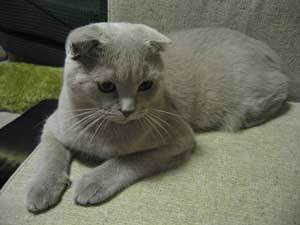 Breed Description: The Scottish Fold is an unusual looking breed. They are medium-sized muscular cat with a fairly heavy bone structure and are famous for having ears that fold forward and downward. The tips of their ears are rounded and they are set on their head in cap-like fashion. They have a round head with large, expressive eyes, a long tapering tail, and a dense, double coat that is very soft and resilient.
Breed Description: The Scottish Fold is an unusual looking breed. They are medium-sized muscular cat with a fairly heavy bone structure and are famous for having ears that fold forward and downward. The tips of their ears are rounded and they are set on their head in cap-like fashion. They have a round head with large, expressive eyes, a long tapering tail, and a dense, double coat that is very soft and resilient.
History & Origin: This breed started in 1961 when a white cat with folded ears was born in Perthshire, Scotland. The male kitten, Snowball, was bred with suitable domestic shorthairs and soon became an established new breed named the Scottish Fold.
Character & Temperament: This breed has a sweet nature. They are generally laid back and respectful of people and property. Scottish Folds get along well with other cats and dogs if introduced properly. They are slow to anger and more likely to remove themselves from a situation than become aggressive. This makes them excellent companions for children. They have quiet voices and are seldom vocal. They enjoy the company of people, but also do fine when left on their own during the day.
Color: The Scottish Fold can be any color or pattern that is considered "natural" for a domestic cat. The most common colors include blue, white, red, black, and cream, sometimes with white and tabby markings.
Coat Type: This breed has a dense and soft double coat that stands out from the body instead of lying flat.
Grooming: The Scottish Fold's coat can be kept in top condition with minimal grooming. When the cat is shedding, a rubber mitt or brush will help loosen and remove dead hair. Claws should be trimmed and ears cleaned only when necessary.
Health Considerations: This breed is not normally crossed with each other due to the possibility of genetic defects resulting in skeletal abnormalities. White cats are prone to deafness.
Trivia: Scottish Folds usually average 5 kittens per litter, with only 2 of the kittens developing the trademark folded ears.
Check out these photos.
Priss is 3 years old this month. He is a mix, but we are told he is part Scottish Fold. We found him through our local paper.